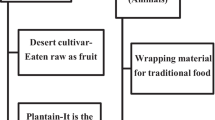Abstract
The goals of the present studies were: (1) to obtain smoking material from tobacco with reduced toxicity; (2) to use the tobacco leaf, as an alternative to other plants, as a source of food protein. On the grounds of technological, nutritional and agronomical results, the following observations can be made: (1) It is feasible to lower the toxicity of the tobacco smoke by extracting protein from the green leaves before curing. (2) The cured deproteinized tobacco can easily be utilized for the production of smoking material without any important alteration of its taste. (3) The composition of the tobacco protein concentrate is very interesting and is superior to other protein concentrates. (4) Itsin vivo andin vitro digestibility is one of the highest among the vegetable protein sources which have been studied. (5) Use of high planting densities and high levels of nitrogen fertilization per hectare results in high yields of total protein from tobacco (1794 Kg/ha).
Similar content being viewed by others
References
A.O.A.C. (1968) Official Methods of Analysis
Corco Benedetti P, Tagliamonte B, Bises G, Gentili V, Spadoni NA (1981) Evaluation of protein quality. Am J of Nutrition and Metabolism 25:48–58
DeJong DW, Lam JJ (1979) Application of homogenized leaf curing to protein recovery and to the alteration of leaf chemistry for production of less hazardous tobacco. Tob Res 5(1):1–27
DeJong DW, Lam S, Lowe R, Yoder E, TSO TC (1975) Homogenized leaf curing 2. Bright tobacco. Beitr Zur Tabak 8:93–101
Dumery B, Albo JP, Chouteau J (1981) Approche analytique des proteines de tabac. Implications technologiques. Under Press, SEITA (Institut Expérimental du Tabac) Bergerac, France
Fantozzi P (1980) Quando il tabacco non va solo in fumo. Giornale dell'Agricoltura, 90(22):48–49
Fantozzi P (1980) La via italiana del tabacco. Salve 4(2):65–67
Fantozzi P (1980) Considerazioni introduttive sul recupero di proteine da foglie di tabacco e sulla loro possibile utilizzazione alimentare. Tecn Alim 1:31–35
Fantozzi P, Garofolo L, Sensidoni A (1982) Utilizzazione del tabacco come fonte alimentare: Nota III. Influenza di alcune variabili agronomiche sul contenuto in proteine strutturali ed enzimatiche. Industrie Alimentari 195(6):482–488
Fantozzi P, Neri M, Sensidoni A (1982) Utilizzazione del tabacco come materiale da fumo e come possibile fonte alimentare: Nota I. Valutazione del tabacco da fumo deproteinizzato. Industrie Alimentari 193(4):277–282
Fantozzi P, Sensidoni A (1981) Utilizzazione del tabacco come materiale da fumo e come possibile fonte alimentare. Proceedings of Congress: ‘Problemi e prospettive della tabacchicoltura to scana’ Arezzo, marzo 1981
Fantozzi P, Sensidoni A (1982) Utilizzazione del tabacco come materiale da fumo e come possibile fonte alimentare: Nota II. Valutazione della frazione proteica. Industrie Alimentari 194(5):375–383
FAO/WHO (Food and Agriculture Organization/World Health Organization.) (1973). Energy and Protein Requirements. WHO Tech Rep Series No 522, FAO Nutrition Meetings Report No 52. FAO/WHO, Geneva
Fiorentini R, Pachetti G, Galoppini C (1978) Attualità e prospettive del frazionamento umido dei foraggi. Istituto di Industrie Agrarie, Università di Pisa
Floridi A, Fidanza F (1975) Valutazione della qualità proteica mediante digestione enzimatica in vitro. S and TA-NU 5:13
I.S.O. (1975) International Organization for Standardisation Methods.
Jones A (1974) Proteins in diet. In: Jones A (ed), World Protein Resources. Lancaster and London: MTP Publ, page 26
Kohler GO, Edwards RH, Lyon CK, McDonald D (1980) Commercialization of the Pro-xan Process for the Production of Leaf Protein Concentrate. A.C.S. Society North Am Chem Congress, Las Vegas, NV, pp 1–14
Leaf Protein International Inc (1982) Raleigh N Carolina. The Story of Proleaf
Long RC (1970) Tobacco Production for Protein Projects No 03245, 50–62. North Carolina State University Raleigh NC
MAF (1980) Metodi Ufficiali Italiani di analisi (Istituto Poligrafico delle Stato) Rome
Masseroni V (1978–79) Isolamento e purificazione della D — Ribulosio 1–5 Difosfato Carbossilasi presente nelle foglie di Lemna minor. Ph D Thesis Università degli Studi di Pavia, Italy
Montedoro G (1969) Ricerche sulla polifenolossidasi delle uve: II estrazione, purificazione e caratterizzazione dell'enzima. Industrie agrarie, 7:259–267
Pompei C, Lucisano M (1974) Purificazione delle proteine di soia per ultrafiltrazione diafiltrazione. La Riv Ital Sost Grasse, 51:149–154
Samons KW, Hegested DM (1977) Animal Biossay. In: Bodwell CE (ed), Evaluation of Proteins for Human. Westport: AVI Press, pp 68–80
Sensidoni A, Garofolo L, Fantozzi P (1981) Utilizzazione del tabacco come possibile fonte alimentare. Nota 2: effetto di alcune variabili agronomiche sul contenuto proteico delle foglie. Proceedings of ‘Giornata tecnica della tabacchicoltura italiana’, CNR-ESAU Foligno 25 maggio, Italy
Sheen SH (1982) University of Kentucky, Lexington. Unpublished data
Singleton VL, Sullivan AR, Kramer C (1971) An analysis of wine to indicate ageing in wood or treatment with wood chips or tannic acid. Am J of Enol Vitic 22:161–170
Staron T (1981) Technologies agroalimentaires INRA-Lucé; 317–342
Tso TC (1972) The potential for producing safer cigarette tobacco. Agric Sci Rev 10:1–10
Tso TC (1977) Tobacco as Potential Food Source and Smoke Material. Beitr Zur Tabak, 9(2):63–66
Tso TC, Gori GB (1972) Effect of tobacco characteristics on cigarette smoke composition. In: Schmeltz I (ed), The Chemistry of Tobacco and Tobacco Smoke. New York: Plenum Publ Corp pp 51–63
Tso TC, Lowe RH, DeJong DW (1975) Homogenized leaf curing I. Theoretical basis and some preliminary results. Beitr Zur Tabak 8:44–51
Usda-Sea USA, (1977) Technical Bulletin No. 1551
Wildman SG (1978) II tabacco é nutriente. Salve 3(12):58–63
Wildman SG, Kwanyuen P, Ershoff BH (1977) Production and Biological Evaluation of crystalline fraction I protein from Tobacco leaves. Proceedings of ‘Non Conventional Proteins and Foods Conference’, Madison Wisconsin
Author information
Authors and Affiliations
Rights and permissions
About this article
Cite this article
Fantozzi, P., Sensidoni, A. Protein extraction from tobacco leaves: technological, nutritional and agronomical aspects. Plant Food Hum Nutr 32, 351–368 (1983). https://doi.org/10.1007/BF01091194
Issue Date:
DOI: https://doi.org/10.1007/BF01091194




